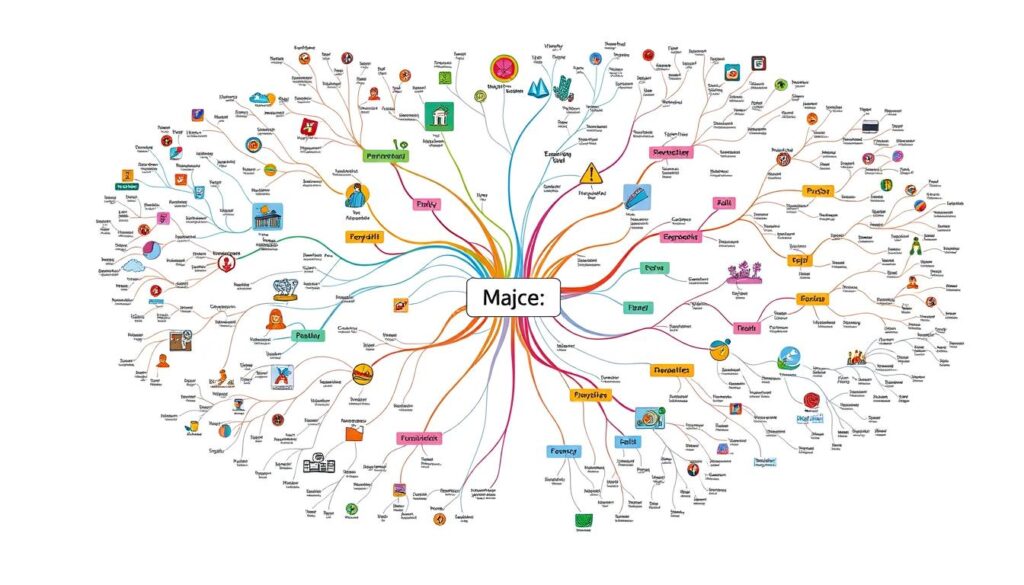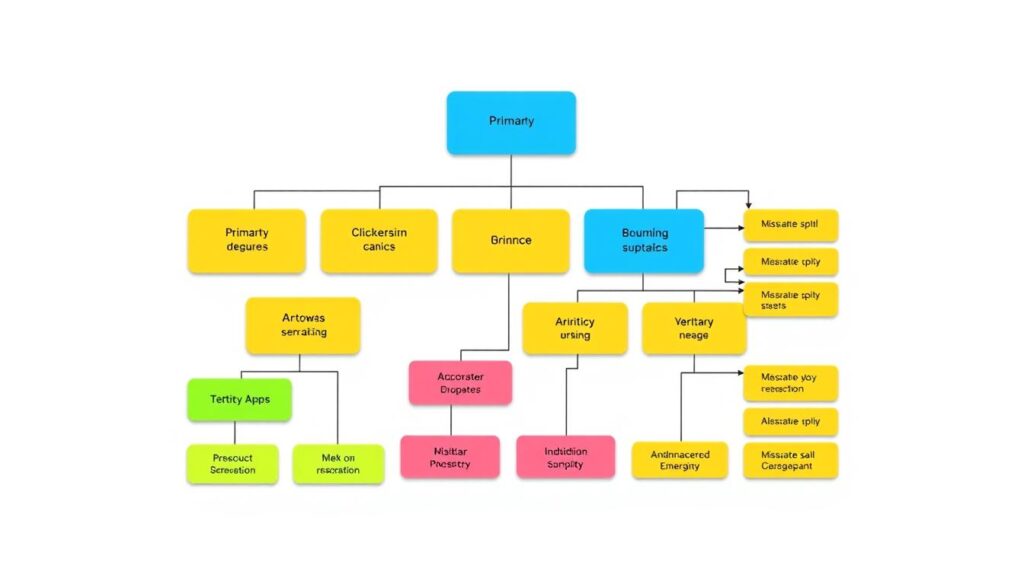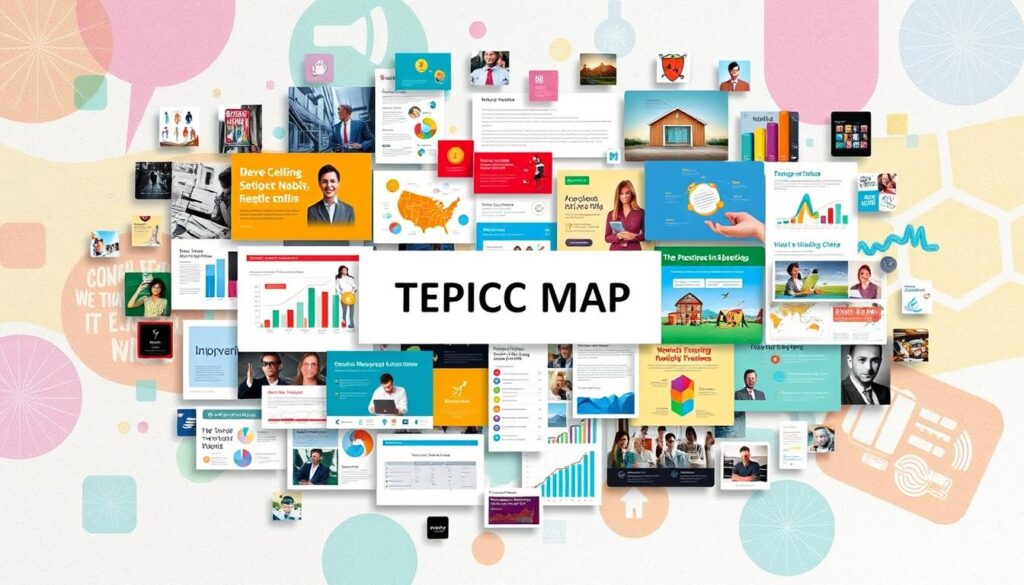
In a crowded digital market, an effective topical map SEO is crucial for standing out. Research shows that well-structured topic clusters improve search rankings. This guide provides actionable steps to build a topical map SEO, boosting your website’s visibility, authority, and performance in search results.
Learning about topical map SEO lets you organize your content well. You’ll target the right keywords and give users a smooth experience. This guide will give you the tools and methods to improve your website’s online presence.
Key Takeaways
- Understand the core concept of a topical map and its significance for SEO
- Identify and research your primary topic to lay the foundation for a comprehensive topical map
- Conduct thorough keyword research to uncover relevant topics and subtopics
- Organize and structure your topical map to ensure a clear hierarchy and information architecture
- Create high-quality, optimized content that aligns with your topical map strategy
What is a Topical Map SEO?
In the world of SEO, a topical map is key for organizing your website’s content. It’s a visual guide showing how different topics and subtopics are connected. By making a detailed topical map, you boost your website’s search engine ranking.
Defining Topical Maps and Their Importance in SEO
A topical map is a smart way to plan and organize your content. It starts with your website’s main topic and then maps out related subtopics and keywords. This method makes sure your content meets user needs and search engine standards.
Benefits of Creating a Comprehensive Topical Map
- Improved content organization and information architecture
- Enhanced what is topical map seo and relevance for target keywords
- Increased internal linking opportunities to boost advantages of topical maps
- Better content optimization and on-page SEO
- Reduced content duplication and improved content quality
- Increased website authority and search engine trust
Creating a well-organized topical map helps search engines understand and rank your pages better. This can lead to more visibility, quality traffic, and better SEO performance. Furthermore, SEO reporting offers actionable insights, enabling you to refine your strategy and enhance overall performance.
Identifying and Researching Your Primary Topic
Finding and studying your main topic is key to a good SEO topical map. You need to dive into your website or blog’s core subject. Understand what your audience is looking for and who your competitors are.
To start, you must identify your primary topic. Look at your business, products, or services to find the main theme that interests your audience. Think about: What value do I offer? What products or services do I have? What problem do I solve for my customers?
- Make a list of possible primary topics that match your business and audience.
- Check each topic for search volume, competition, and how well it fits your audience.
- Pick the best primary topic to focus on for your topical map.
Then, you should research your primary topic well. Look into what people are searching for, who your competitors are, and find related sub-topics and keywords. Use keyword tools, analyze competitors, and get insights from the industry to get all the data you need.
| Research Tool | Key Insights |
|---|---|
| Google Keyword Planner | Search volume, competition, and related keywords for your primary topic |
| SEMrush or Ahrefs | Competitive analysis, including top-ranking websites and content for your primary topic |
| Industry forums and communities | User queries, pain points, and related sub-topics for your primary topic |
By thoroughly researching your primary topic, you’ll understand what your audience wants, who you’re up against, and the important sub-topics and keywords for your map. This knowledge is crucial for your SEO strategy.
Conducting Keyword Research for Topical Maps
Creating a good topical map for SEO starts with keyword research. This step is key to finding the right keywords. It makes sure your content meets your audience’s needs and matches their search intent. Partnering with an SEO agency can help streamline this process by leveraging expert insights and advanced tools to craft a comprehensive topical strategy.
Tools and Techniques for Effective Keyword Research
Many tools and methods can help with keyword research. Google Keyword Planner, SEMrush, Ahrefs, and Ubersuggest are some of them. They give insights into keyword popularity, competition, and relevance. Using these tools can open up many keyword research for topical map opportunities and improve your strategy.
Analyzing Search Intent and User Queries
It’s not just about finding popular keywords. You also need to analyze search intent and understand how users ask questions. This helps you create content that answers their needs. Tools like Google Trends and Answer the Public are great for analyzing search intent for topical map optimization.
By combining strong keyword research for topical map, tools for keyword research, and understanding search intent, you can make a detailed topical map. This map will connect with your audience and help your SEO efforts.
Organizing and Structuring Your Topical Map
Making a good topical map for your website needs a clear hierarchy and info architecture. This plan makes your content easy to find for search engines and users. It also makes your site more visible and user-friendly. Partnering with professional web development services can help streamline this process, ensuring your site is optimized for both functionality and SEO.
Establishing a Clear Hierarchy and Information Architecture
Start by picking your main topic and its subtopics. Put these in a logical order, making it easy to follow. Your site’s navigation and content should show this order clearly. This helps visitors find what they need quickly.
- Determine your main topic or focus area
- Identify and group related subtopics under the primary topic
- Arrange the subtopics in a logical, hierarchical order
- Ensure the information architecture aligns with user search intent and behavior
- Optimize your website’s navigation to mirror the topical map structure
Creating a clear topical map hierarchy and architecture makes your site easy to use. It also helps organize topical map and structure topical map for better search engine rankings.

“A well-structured topical map is the foundation for effective content organization and search engine optimization.” – SEO Expert
| Best Practices for Topical Map Hierarchy | Benefits of a Structured Topical Map |
|---|---|
|
|
Creating Comprehensive Topic Clusters
In SEO, topic clusters are very powerful. They are like a web of content that makes your site strong and trusted. By creating topic clusters, you can build topic clusters for SEO and make a comprehensive topical map that your audience loves.
Search engines like sites that cover a topic fully. By organizing your content into topic clusters, you show you know your stuff. You meet your audience’s needs and get more seen in search results.
To make comprehensive topic clusters, pick a main topic and do deep keyword research. Then, build a network of related subtopics. This makes sure your site covers all parts of a topic well. It also makes visiting your site easy and fun.
- Begin with your main topic and do deep keyword research to find subtopics and questions your audience wants answers to.
- Put these subtopics in order, making a clear map that helps users and search engines find their way.
- Make great, engaging content for each subtopic. Make sure it’s valuable and meets your audience’s needs.
- Link your content together, creating a strong comprehensive topical map that improves the user experience.
- Keep an eye on your topic clusters and update them as search trends and user preferences change. This keeps you seen as a trusted expert in your field.
Mastering comprehensive topic clusters can really boost your SEO. It brings more organic traffic, makes your brand a leader, and helps you succeed online in the long run.
| Benefits of Comprehensive Topic Clusters | Challenges to Overcome |
|---|---|
|
|
“Comprehensive topic clusters are the key to unlocking the full potential of your SEO strategy. By providing a holistic, in-depth exploration of your subject matter, you can establish your brand as a trusted authority and captivate your audience.”
Developing High-Quality Content for Your Topical Map
Making great content is key to a good topical map SEO plan. You need to make your content good for both search engines and your readers. This way, more people will find and enjoy your site.
Optimizing Content for Search Engines and Users
Knowing what your audience wants is important. Do some keyword research to find out what they’re looking for. Then, use those words in your content.
Make sure your content is easy to read. Use clear headings and short paragraphs. This helps both search engines and people understand your content better.
Don’t forget about the technical stuff. Things like meta tags and image optimization help your content get found. Use free tools like Attrock’s Meta Tag Analyzer to optimize meta tags and improve your website’s search rankings significantly. They also make your site easier to use by enhancing loading times and providing clearer, more relevant information to search engines and users alike.
Incorporating Multimedia and Visual Elements
Adding pictures, videos, and interactive stuff makes your content more fun. It also helps people remember what they read. This makes your content more engaging.
By creating high-quality content for your topical map, optimizing it for search engines and users, and adding multimedia to your topical map, you’ll make a great resource. It will attract your audience and boost your SEO.

Completing a Topical Map SEO
Making a detailed topical map is key to getting your website noticed by search engines. To finish your topical map SEO, we’ll look at the last steps. These will help you complete your map and make it work its best.
Start by checking your topical map to make sure it has all the important topics and subtopics. The aim is to build a complete and connected content network that gives value to your audience. Look over the map’s structure, organization, and flow. See if there are any missing parts or areas that need more work.
- Check if your topical map’s structure is solid and all topics are well-connected.
- Find chances to make new content or grow existing pieces to cover any gaps.
- Refine the topic clusters, making sure they fit together well and are relevant to your main focus.
Then, make your topical map better for search engines by adding the right keywords and phrases in your content. This makes search engines see your website’s context and relevance, boosting its visibility and rankings.
Lastly, look at your topical map as a whole to make sure it fits with your content strategy and marketing goals. Adjust anything needed to make sure your topical map is helping you get more traffic, engagement, and conversions.
By doing these steps, you’ll have a fully optimized topical map. It will be a strong base for your SEO efforts. It will help you rank better, get more relevant visitors, and make your website a trusted source in your field.
Interlinking and Internal Linking Strategies
Creating a good topical map for SEO is not just about making great content. It’s also about setting up strong interlinking and internal linking strategies. These help improve the user experience and boost your website’s search engine ranking.
Enhancing User Experience and SEO with Proper Linking
By linking your topical content well, you make it easy for users to find more information. This makes their experience better and tells search engines your content is valuable. This can help your site rank higher in search results.
When you plan your internal linking, aim for links that make sense and fit the user’s needs. Don’t overdo it with too many links that don’t add value. Choose the best connections between your content to make navigation easy and informative for your visitors.
FAQ
1. How do I identify and research my primary topic?
Start by analyzing your business and products to find your main topic. Research your audience and the competitive landscape. This will help you understand your primary topic and its importance.
2. What tools and techniques should I use for keyword research in Topical Map SEO?
For keyword research, use tools like Google Keyword Planner, Semrush, and Ahrefs. They help find relevant keywords and understand search intent. Also, consider user surveys, social media listening, and competitor analysis.
3. How do I organize and structure my Topical Map?
Organize your Topical Map by grouping related topics and subtopics. Arrange them in a logical structure. Make sure it aligns with your audience’s search behavior for a smooth user experience.
4. What is the importance of creating comprehensive Topic Clusters?
Topic Clusters are vital for Topical Map SEO. They show your website’s authority and expertise to search engines. This improves your rankings and offers a valuable experience for your audience.
5. How do I develop high-quality content for my Topical Map?
Create content that is informative, engaging, and meets your audience’s needs. Use relevant keywords, multimedia, and a user-friendly layout. This optimizes your content for search engines and users.
6. How can I use Interlinking and Internal Linking Strategies to enhance my Topical Map SEO?
Strategic interlinking and internal linking improve your Topical Map SEO. They help users navigate your site and show search engines your content’s relevance and authority.



